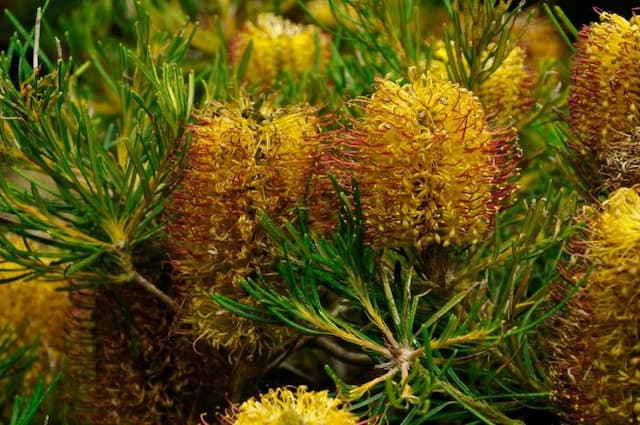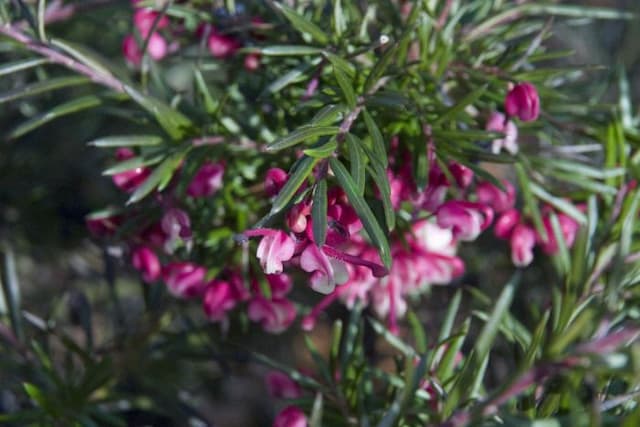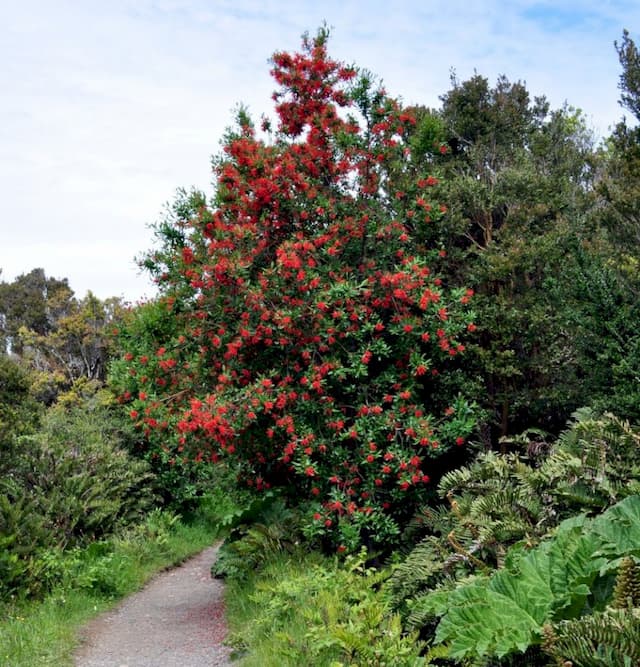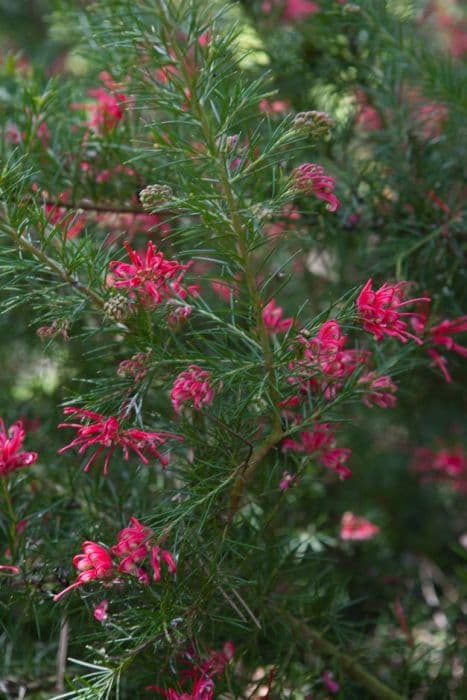King Protea Protea cynaroides

ABOUT
The king protea, as it is commonly known, is a striking plant distinguished by its large and showy flowers that are arguably the most captivating feature. These flowers are composed of a central dome-shaped cluster of deep pink to crimson, occasionally creamy white, florets. They are surrounded by large, stiff, and pointed bracts that can vary in color from a pale pink to a deep magenta, often with a silvery sheen. The flower head is reminiscent of an artichoke, both in structure and appearance, which is not surprising given that the plant's name is derived from their similarity to the artichoke's Latin name. The foliage of the king protea consists of leathery leaves that are broad, oblong, and can range in color from a bright green to a grayish tone. These leaves are thick and often have a waxy or velvet-like texture, with distinct midribs and noticeable veins. The leaves typically grow in a whorled arrangement at the end of thick stems, which highlights the plant's robust and substantial nature. Overall, the appearance of the king protea is characterized by its lush, evergreen leaves and the dominant flower heads that make it an extraordinary specimen in any setting where it is found. Its unique floral display is not only a splendid sight but has also led it to be one of the most popular and recognizable flowers, representing a symbol of resilience and natural beauty.
About this plant
 Names
NamesFamily
Proteaceae.
Synonyms
King Protea, Giant Protea, Honeypot.
Common names
Protea grandiflora, Leucadendron cynaroides, Scolymocephalus grandiflorus.
 Toxicity
ToxicityTo humans
The King Protea (Protea cynaroides) is not commonly known to be toxic to humans. There is no significant evidence of the plant causing poisoning upon ingestion. Typically, it is grown for ornamental purposes, and while it's not recommended to consume any part of ornamental plants without verifying their edibility, the King Protea is not associated with toxic effects in humans.
To pets
The King Protea (Protea cynaroides) is not commonly known to be toxic to pets, such as dogs and cats. There is no significant evidence suggesting that it causes poisoning in animals if they ingest parts of the plant. However, it is always wise to prevent pets from eating plants that are not intended for their consumption, as individual animals may have unique sensitivities or allergic reactions.
 Characteristics
CharacteristicsLife cycle
Perennials
Foliage type
Evergreen
Color of leaves
Dark green
Flower color
Mixed
Height
3-4 feet [0.9-1.2 meters]
Spread
6-10 feet [1.8-3 meters]
Plant type
Shrub
Hardiness zones
9
Native area
South Africa
Benefits
 General Benefits
General Benefits- Ornamental Value: With its large, striking flowers and unique appearance, the King Protea is widely used as an ornamental plant in gardens and landscaping projects.
- Drought Tolerance: Native to South Africa, the King Protea is well adapted to dry climates, requiring minimal water once established, making it suitable for xeriscaping.
- Pollinator Attraction: The flowers attract a variety of pollinators, including birds and insects, supporting local biodiversity.
- Long-lasting Cut Flowers: The King Protea's blooms are very durable and can last for several weeks in a vase, making them popular in the cut flower industry.
- Symbolic Value: As the national flower of South Africa, the King Protea holds cultural and symbolic importance.
- Erosion Control: The plant's root system can help stabilize soil, reducing erosion on sloped landscapes.
- Adaptability: Protea cynaroides can adapt to different soil types, although it prefers well-drained acidic soils, making it versatile for different garden settings.
 Medical Properties
Medical PropertiesThis plant is not used for medical purposes.
 Air-purifying Qualities
Air-purifying QualitiesThis plant is not specifically known for air purifying qualities.
 Other Uses
Other Uses- Protea cynaroides, commonly known as the King Protea, is used as a national symbol in South Africa, appearing on passports and coins, representing the country's rich biodiversity.
- The large and dramatic blooms of the King Protea make them popular in bridal bouquets and floral arrangements for their unique appearance and long-lasting qualities.
- The flower of the King Protea is used as a symbol of change and transformation due to its ability to adapt to wildfires by reseeding and regenerating quickly afterwards.
- Given its resilience to fire, the King Protea is sometimes planted by gardeners and landscapers in fire-prone areas as a fire retardant and to help stabilize the soil post-fire.
- Illustrations and photographs of the King Protea are often used in art and design, inspiring patterns and motifs for textiles, wallpapers, and other aesthetic applications.
- The unique structure of the King Protea flower makes it a subject of study in biological and botanical sciences, helping understand pollination mechanisms and plant architecture.
- Kids often use the large, distinctive seed pods of the King Protea in school projects or crafts for their interesting texture and shape.
- The King Protea is planted in gardens and parks for educational purposes, allowing visitors to learn about South Africa's native flora and the importance of plant conservation.
- Dried King Protea flowers are a popular choice for dry flower arrangements and crafts, as they retain their shape and color well after drying.
- Culinary uses of the King Protea nectar include the creation of specialty syrups and sugars for cocktails and gourmet desserts, prized for their exotic flair.
Interesting Facts
 Feng Shui
Feng ShuiThe King Protea is not used in Feng Shui practice.
 Zodiac Sign Compitability
Zodiac Sign CompitabilityThe King Protea is not used in astrology practice.
 Plant Symbolism
Plant Symbolism- Change and Transformation: Protea cynaroides, commonly known as King Protea, symbolizes diversity and courage since it can adapt to various environmental conditions.
- Hope: It embodies hope because of its ability to endure challenging conditions and still flourish.
- Diversity: The King Protea has a wide range of colors and forms which represent the beauty of diversity in life.
- Uniqueness: With its unusual appearance, the King Protea signifies the value of standing out and being unique in a crowd.
- Longevity: Known for its long lifespan and lasting qualities, the Protea represents longevity and a lasting impression.
 Water
WaterFor the King Protea, it's essential to maintain moderate soil moisture without waterlogging. Water this plant every one to two weeks, providing about one gallon of water per session during active growth in the spring and summer months. Cut back watering to every three to four weeks in the winter when the plant is dormant, adjusting for rainfall and soil type. Always allow the soil surface to dry out between watering to prevent root rot. A deep watering method is most beneficial, encouraging deeper root growth and greater drought tolerance.
 Light
LightKing Protea thrives in full sun to partial shade, requiring at least six hours of direct sunlight daily. The best spot for this plant is in a south-facing garden that offers bright and sustained light exposure. If grown indoors, a sunny window with ample light would be an ideal location.
 Temperature
TemperatureThe King Protea prefers mild climates and can tolerate temperatures between 50°F and 75°F for optimal growth. It can withstand brief dips down to 40°F, but temperatures below this may cause damage to the plant. Avoid prolonged exposure to frost, as it is not frost-tolerant.
 Pruning
PruningPrune the King Protea after flowering to maintain shape and encourage new growth; this is typically best done in late winter or early spring. Remove spent blooms, dead or damaged branches, and thin out any dense areas to improve air circulation. Pruning can be done annually as part of routine maintenance.
 Cleaning
CleaningAs needed
 Soil
SoilThe King Protea requires well-draining acidic soil with a pH between 5.5 and 6.5. A good mix would be equal parts of coarse sand or perlite, peat moss, and loamy soil to ensure proper drainage and aeration.
 Repotting
RepottingThe King Protea should be repotted every 2 to 3 years or when it outgrows its pot. Minimize root disturbance to prevent transplant shock.
 Humidity & Misting
Humidity & MistingThe King Protea thrives in moderate to low humidity levels, preferring conditions similar to its native South African environment.
 Suitable locations
Suitable locationsIndoor
Give King Protea bright light, cool temperatures, and avoid excess watering.
Outdoor
Place King Protea in full sun with well-draining soil and shelter from frost.
Hardiness zone
9-11 USDA
 Life cycle
Life cycleThe life cycle of the King Protea (Protea cynaroides) begins with seed germination, which occurs after fire or when conditions are favorable, such as warm temperatures and sufficient water. The seedlings establish a deep root system to absorb nutrients and water. Following the juvenile stage, the plant enters the vegetative stage, where it develops its distinctive large leaves and sturdy stem. After several years, the King Protea progresses to the reproductive stage, producing large, showy flowers that attract pollinators like birds and insects. Once pollination occurs, seeds develop and are typically stored in fire-resistant structures called infructescences until they are released by environmental triggers like fire. The plant can live for many years, with individual plants often surviving for over a decade, entering a period of senescence before eventually dying.
 Propogation
PropogationPropogation time
Spring to Summer
The King Protea, scientifically known as Protea cynaroides, can be propagated chiefly by seed or vegetative methods. The seed is the most popular method, typically sown in the fall, which corresponds to autumn in the Southern Hemisphere where this plant is native. To propagate by seed, the first step involves extracting seeds from the dried flower head. The extracted seeds should then be sown in a well-draining soil mix at a shallow depth, lightly covered with the same mix. The soil must be kept moist but not waterlogged, and the seeds usually germinate within 1 to 3 months when kept at a temperature of around 70 to 75 degrees Fahrenheit (21 to 24 degrees Celsius). Once the seedlings are large enough to handle, they can be transplanted into individual pots and grown on until they are ready to be planted out.









